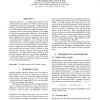Free Online Productivity Tools
i2Speak
i2Symbol
i2OCR
iTex2Img
iWeb2Print
iWeb2Shot
i2Type
iPdf2Split
iPdf2Merge
i2Bopomofo
i2Arabic
i2Style
i2Image
i2PDF
iLatex2Rtf
Sci2ools
121
Voted
ISMIR
2005
Springer
2005
Springer
Learning Harmonic Relationships in Digital Audio with Dirichlet-Based Hidden Markov Models
Harmonic analysis is a standard musicological tool for understanding many pieces of Western classical music and making comparisons among them. Traditionally, this analysis is done on paper scores, and most past research in machine-assisted analysis has begun with digital representations of them. Human music students are also taught to hear their musical analyses, however, in both musical recordings and performances. Our approach attempts to teach machines to do the same, beginning with a corpus of recorded Mozart symphonies. The audio files are first transformed into an ordered series of normalized pitch class profile (PCP) vectors. Simplified rules of tonal harmony are encoded in a transition matrix. Classical music tends to change key more frequently than popular music, and so these rules account not only for chords, as most previous work has done, but also for the keys in which they function. A hidden Markov model (HMM) is used with this transition matrix to train Dirichlet dis...
Classical Music | Information Retrieval | ISMIR 2005 | Transition Matrix | Western Classical Music |
Related Content
| Added | 27 Jun 2010 |
| Updated | 27 Jun 2010 |
| Type | Conference |
| Year | 2005 |
| Where | ISMIR |
| Authors | J. Ashley Burgoyne, Lawrence K. Saul |
Comments (0)

